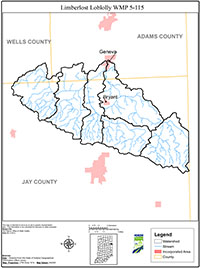Summary
This Watershed Management Plan was created as a result of a desire by the Friends of the Limberlost State Historic Site to reduce pollution from nonpoint sources and restore the three “Limberlost” watersheds to a more ecologically healthy condition. In order to accomplish this, the group focused its attention on five main areas:
- Ecological restoration
- Nonpoint source pollution (sediment and nutrients) from row crop agriculture
- Nonpoint source pollution (bacteria and nutrients) from livestock farming
- Stream habitat degradation from channelization and lack of vegetated riparian buffers
- Education for landowners in the watershed and community members on nonpoint source pollution problems and solutions
The steering committee developed goals to address each of the five topics. The Biological Restoration Goal aimed to restore natural ecological communities in the watersheds, wherever possible. The Cropland Agriculture Goals included making application of fertilizer more efficient, decreasing the use of unnecessary ditching practices on streams in the watershed, and increasing the use of conservation tillage in the watershed, especially for corn Livestock. The Agriculture Goals focused on the promotion of using of alternative manure management systems and the fencing of livestock from waterways, where possible. The Riparian Goals focused on installing vegetative buffer strips along all stream channels and restoring wetlands, wherever possible. Finally the Educational Goals included educating the public on the importance of habitat, providing information on proper septic system maintenance and good manure management practices, and encouraging the use of environmentally sensitive channel maintenance.
No water quality monitoring was conducted as part of this planning process. Instead, the Friends of the Limberlost carried out a comprehensive documentary of stream condition by photographing streams at each road crossing. A total of 175 road crossings were photographed. Thirty-seven of these showed the absence of a vegetative filter strip along one or both sides of the road. Franks Drain in Wabash Township had the highest number of sites (15) lacking filter strips. As part of this planning grant, the committee also produced two educational brochures and put on four water quality workshops (two on septic systems, one on manure composting, one on aquatic life). While the planning process was underway, the committee found and eliminated a broken sewer connection draining into Loblolly Creek from the Town of Geneva and repaired a leaking septic system for one household. Finally, additional water quality related projects that were carried out by partners in the watershed during the 2-year grant period included: Jay County grassed waterway project, Limberlost Swamp Restoration projects, and the Red Gold wetland restoration project.

